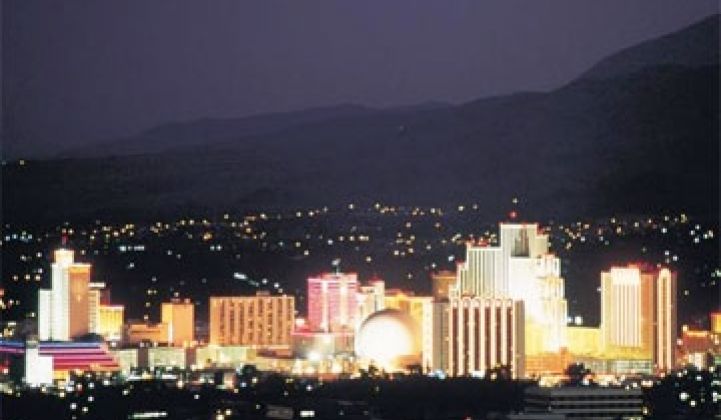Most of Nevada remains sparsely populated, but the state now generates more geothermal power than all but eight of the world's nations, according to the Geothermal Energy Association (GEA). And that's only an indication of geothermal's potential as a player at the renewables table.
"It was only five or six years ago that people had no idea what geothermal could be," Karl Gawell, the Executive Director of the GEA, said. "There was tremendous uncertainty and utilities were totally skeptical."
During the renewables expansion that has taken place from 2005 to 2010, geothermal's installed capacity in Nevada doubled from 200 megawatts to over 400 megawatts. Projects currently in development could add as much as 3,000 megawatts to Nevada's grid.
"Some of the major utilities, like NV Energy, have become real believers," Gawell said. "A few years ago, geothermal was in just four states: Utah, Nevada, California and Hawaii. Now every state from Alaska to Texas has geothermal projects."
A lot of money is being bet on geothermal, particularly in the upfront equity financing of test wells. Though the science of identifying geothermal's deep pockets of hot water is improving, a geothermal exploration well remains a bet of as much as half the project cost, made on the presence or evidence of a hot spring.
But large and small companies alike are making that bet. Calpine, a veteran independent power producer in the natural gas industry, is active. So is CalEnergy Generation, a part of Warren Buffett's MidAmerican Energy. Nevada Geothermal Power, a company on the Canadian stock exchange, is playing. So are startups U.S. Geothermal and Ram Power.
The recession slowed, but did not stop, development. A developer cannot get bank financing today until 80 percent of the work to prove the resource has been done. Just a few years ago, Gawell said, bank financing came with as little as 30 percent of the work done.
Asked why Nevada's geothermal industry has held up so strongly, Gawell listed three reasons. "Strong state policies," he said, specifying a Renewable Energy Standard dictating that 25% of the state's energy come from renewable sources by 2025, among the nation's most ambitious. "Tax incentives from Congress, particularly the tax incentives passed as part of the stimulus package," citing the Treasury's cash grant-in-lieu of tax credits program that has sustained all the renewable industries through the recession. Lastly, Gawell singled out the federal government's support of research at the University of Nevada, Reno, "to help them do the scientific and technical work to identify and find geothermal reservoirs."
"The U.S. Geologic Survey estimates that as much as 80 percent of all the resources are still undiscovered," Gawell said. "We simply don't have the science and technology to help us find them without drilling holes in the ground -- and that's pretty expensive."
Geothermal developers, he said, are like pre-World War I oil wildcatters looking for seeps. "We are still finding geothermal mainly because there's a hot spring. But there may be 80,000 megawatts of undiscovered resource. That's what we really need to figure out how to get to."
Though stimulus bill money is funding discovery advances, the geothermal conversation continues to be about high exploration costs and the unrealized promise of the oft-maligned and misunderstood Enhanced Geothermal Systems (EGS).
Using EGS, producers drill deeply into hot rocks and pump surface water to them. The heat is transferred to the water and it is pumped back to the surface with geothermal energy that is used in a standard geothermal power plant. Much heralded until recently, EGS began to garner controversy when its deep fracturing of geologic structures seemed to be associated with increased seismic activity, first in Basel, Switzerland, and later in California.
"What EGS really means is doing some amount of engineering work," Gawell said. "In Europe, they are doing EGS projects right now," he explained. "They are doing dozens of them." Much smaller and more wisely sited than the Basel and California projects, many of these European projects are producing power without adding to the controversy. Small-scale EGS projects are economic because of European feed-in tariffs, Gawell said. If the U.S. had such incentives, similar EGS development would surely follow.
As for larger-scale EGS undertakings, Gawell said the U.S. Department of Energy is now developing protocols for prudent development that are being applied by geothermal developers internationally.
"The thing is, you've got to address it," Gawell said. "If you've got major slip faults in the area, you don't do a project there. You simply stay away. When somebody permits a geothermal project in Basel, Switzerland, the site of the biggest earthquake in European history, you have to wonder whether they did any screening or thinking" beforehand.
Gawell admitted, however, that he is not factoring EGS' potential into the GEA's projections for the next ten years. In the more immediate future, he foresees the more salient trend to be conventional new project development, but he expects to see broader participation by utilities, electric co-ops and public power entities.
"One-third of the West's population is served by co-ops and public power. Most of our projects have been private companies. But that's changing."
Gawell also expects an expansion of smaller-scale, distributed generation projects. And he foresees major breakthroughs in water conservation. "Water is always an issue," he said. "Every plant brought on line last year uses a binary power system. And we're seeing an increasing trend toward air-cooling." Geothermal developers are motivated, even more so than others, to conserve water, because the water they lose to cooling comes from their own reservoirs. "In the long run, all power technologies will have to move away from using fresh water for cooling," Gawell said. "It's becoming too rare of a commodity in the West."



